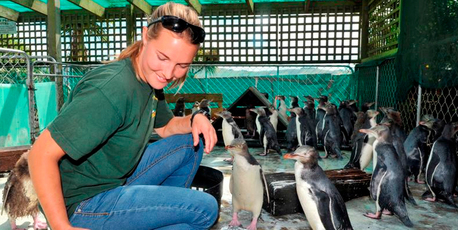
By Rebecca Fox
Wednesday Feb 19, 2014
One of the most "disastrous breeding seasons" in recent years has hit endangered yellow-eyed penguin colonies along Otago's coast. "This is the worst season I've ever seen and it's not over yet," Department of Conservation ranger Mel Young said. It follows last season's "mass mortality" when a mystery illness, possibly caused by a marine toxin, killed 68 adults.
A shortage of food this year meant chicks were struggling to survive the first three months of life - fewer than 70 on Otago Peninsula, compared with more than 200 last season - and those that did were well underweight. A healthy weight for a fledgling penguin was about 5kg. The lowest weight recorded this season was 1.7kg in the Catlins.
North Otago yellow-eyed penguins were also struggling. Katiki Point Penguin Trust recorded the lowest number of chicks per pair since monitoring began there and "dangerously low weights". The majority of chicks in the Catlins and North Otago were in "extremely poor" condition and unlikely to survive to fledge in coming weeks, Ms Young said.
On Otago Peninsula, many nests were reduced to one chick as few adults were able to feed two chicks and many at Penguin Place succumbed to starvation and secondary infections. There were still many year-old penguins due to moult and then the adults. "Moulting may be delayed if these birds are compromised, which will only lead to higher losses of yellow-eyed penguins along Otago's coast."
It was thought La Nina conditions with high sea surface temperatures had resulted in less food being available for the chicks, she said.
A later-than-usual start to the breeding season meant eggs hatched up to four weeks later than usual and might have contributed to the severity of the event. The penguins' poor condition was picked up when DoC, Yellow-eyed Penguin Trust, wildlife veterinarian Lisa Argilla and volunteers did their 80-to-90 day check of chicks to tag them. "We've removed chicks from the wild for supplementary feeding to give them a better chance of survival, but mostly to take the pressure off the adults before they moult."
Yellow-eyed Penguin Trust general manager Sue Murray said low chick weights had also been seen in trust reserves in North Otago, Otago Peninsula and the Catlins. ''The penguin population will not be sustained if in future there continues to be poor breeding years.'' She believed more research was urgently needed to ensure the continued survival of the penguins along the eastern coastline.

Starving penguin influx straining resources
A sudden influx of 80 mostly starving yellow-eyed penguins is stretching the resources of Otago Peninsula's penguin "hospital". "Some, when they first came in, looked awful. They were skinny and sunken-in," Penguin Place rehabilitation co-ordinator Julia Clement said. About 80kg of fish is needed each day to help the penguins gain enough weight so they can head out to sea with a good chance of survival. Supplementary feeding is being provided by Katiki Point Penguin Trust volunteers for 39 chicks in North Otago.Penguin Place's penguin hospital regularly looks after about 100 birds a season, but this year's sudden influx meant having to double the size of its enclosure and provide more food. Manager Lisa King said businesses and fishing companies such as Sanford, Harbourside Fish, United Fisheries and Talley's had been generous at short notice, but even more fish was needed. "We urgently need more fish and would like to hear from fishing companies which can help."
Ms Clement said the penguins were fed twice a day. That and cleaning the pens took two staff 2.5 hours each every day. Some penguins had to be force-fed. Others were able to take food offered by hand. "It's physically exhausting work." The 80 penguins would continue to be fed until they weighed 5kg and were showing signs of being ready to go to sea, Ms Clement said. They would then be released - probably later this month or in early March.
source



















No comments:
Post a Comment